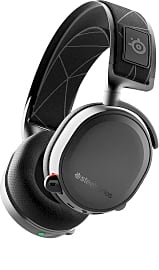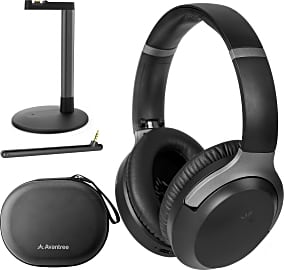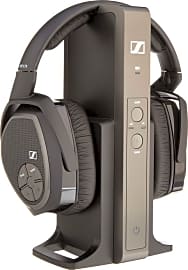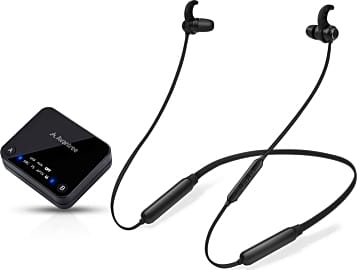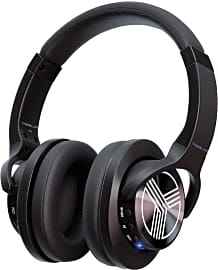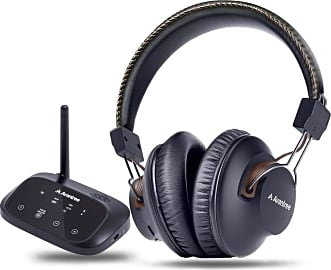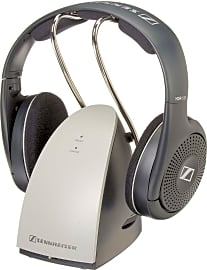The 10 Best Wireless Headphones For TV

This wiki has been updated 31 times since it was first published in December of 2017. If you or someone around you has trouble hearing, or if you just want to watch a movie without disturbing a sleeping partner, consider a pair of wireless headphones, which are specially designed to fully immerse you in your programming without introducing any audio latency. There are various affordable and high-end models that work with modern TVs, Android streaming boxes, and home theater PCs. When users buy our independently chosen editorial choices, we may earn commissions to help fund the Wiki.
Editor's Notes
October 02, 2020:
A few changes have been made for our most recent revision of this ranking, and in all cases we have switched previous items for superior or updated versions of the same brand. First, we replaced the Sony IF245RK with the Sony MDRRF985RK, the latter being an over-ear model, as opposed to the previous on-ear choice. Not only are these more comfortable to wear for longer periods, but they offer better sound-separation, deeper headband cushioning, and their transmitting dock features fast automatic charging and a longer range.
Next, we switched the Avantree HT4189 for the upgraded Avantree HT5009, as while the set includes the same AS9S headphones as previously listed, the Audikast transmitter has been replaced with the Oasis Plus model. This is far more efficient than its predecessor, exceeding its range by up to 64 feet, and can be connected between a soundbar and the TV to stream to the headphones simultaneously. This is especially useful if one of the viewers is hearing impaired, as they can adjust their own volume accordingly.
Similarly, we replaced the Avantree HD280 with the Avantree Aria Me. This recent addition to this brand's line of good quality, affordable headphones has an even greater focus on the hearing-impaired than the previously mentioned Avantree HT5009. They come with an app that allows the user to create their own personalized listening profile and adjust the headphones accordingly, tailoring them to suit their own unique range.
Lastly, we added the Sennheiser RS 195 in place of the Sennheiser RS 165. This flagship model of their TV headphones line is also geared towards addressing the issue of hearing loss over time. They have a number of presets that emphasize their dynamic range for music, or enhance speech intelligibility and reduce background noise for an overall improved listening experience.
June 14, 2019:
There are a few different ways to go if you want to hear your TV clearly without using big speakers. You can get a pair of Bluetooth headphones, which are more and more common these days, but you have to make sure they support a low-latency codec. The TrebLabs, for example, support AptX (which means they also support AptX Low-Latency), but to avoid a lip-sync delay, you'll need an AptX-LL transmitter to go along with them. Avantree solves this problem with a couple different combinations of headphones and their good-quality Bluetooth transmitters, and those options also happen to be some of the most affordable. The drawback of Avantree's budget-friendly bundles is that they don't use the AptX Low-Latency codec, but rather a proprietary one called FastStream that compresses the audio quite a bit more in order to minimize latency. The end result is that they just don't sound as good as AptX would. Incidentally, the transmitters they sell DO, in fact, support AptX, so they'll work with any headphones you might want to use that also support the codec.
After Bluetooth with that caveat, the next and most popular method is RF wireless. Radio frequency transmission takes place on either the 900mHz or 2.4gHz band and doesn't require compression to get the audio signal to the headphones, so there's no inherent lag. The Sennheisers, Avantree HD280, and Artiste all use RF wireless, as does the SteelSeries. For what it's worth, the SteelSeries Arctis 7 is the only one we highlighted that uses a simple USB dongle rather than a bulky base station, which users may or may not find to be a positive.
Then there's the Sony, which uses infrared transmission much like a traditional TV remote, which of course means they'll need to be relatively close to the base station while maintaining a line of sight. But, they won't pick up any static or other interference from the Wi-Fi signals that are probably already coursing through your TV and the rest of your house.
Finally, the Avantree HD280, Sennhesier RS 120, and Sony models were built with the hard-of-hearing in mind, so there's a chance not everyone will be satisfied by their sound. The Artiste strike a good balance in that respect, as elderly users tend to find them effective while younger, more hearing-capable listeners are also generally satisfied.
Special Honors
Sennheiser RS 5000 A slight departure from the open and closed-back headphones that dominate our ranking, these are more like a stethoscope in appearance, but much like their same-brand closed counterparts, they offer a customizable sonic experience with three different sound profiles to choose from. This lightweight and unobtrusive solution also include Sennheiser's excellent speech intelligibility function, making them a good choice for those with hearing impairment. sennheiser.com
Sound Asleep
These devices are incredibly easy to set up, and they’re designed to be as comfortable as possible on your ears, so you can use them for hours of binge watching.
My girlfriend is not the best sleeper. For whatever reason, she requires audio-visual stimulation to help her get off to sleep, which certainly complicates things when bedtime rolls around, as the light and sound of a television is something that’s guaranteed to keep me awake.
For the most part, this wasn’t much of a problem, as I’m also a bit more of the night owl, so she could fall asleep before me with something on television, and I could turn it off once she was out and comfortably get to sleep myself. It was a viable arrangement, and on the few nights when we went to bed at the same time, I would just suffer for 30 of 60 minutes until she was out.
Then I got a gig that had me waking up extremely early in the morning, and I had to turn in early as a result. The thought of sleeping separately was too depressing to entertain, so we set out to find a solution. What we found was a wireless headphone set for the television. Now, when my girl wants to get some sleep, but I’m already off to the land of nod, she can enjoy a show in the background without waking me.
Of course, you may be wondering how I dealt with the light coming off of the TV. The headphones took care of the sound, but even with the screen settings turned way down low, I could still experience that blue glow permeating my eyelids. So, I got myself a nice, expensive, handwoven silk sleep mask to block the light.
These devices are incredibly easy to set up, and they’re designed to be as comfortable as possible on your ears, so you can use them for hours of binge watching. They’re especially useful in other situations where the volume of your television might be a problem. If, for example, your apartment or house has particularly thin walls, and you want to watch something loud (or, perhaps, you want to watch a guilty pleasure), you won’t have to worry about your neighbors or family members being disturbed by the sound. That will also let you watch movies and shows that contain adult themes and language, even if you have a child in the next room.
The Right Wireless TV Headphones For You
When evaluating the various wireless headphones for TV on the market, it may seem as though one option is as good as the next. There are some important differences, however, that could make or break your watching experience, especially if you’re someone whose willing suspension of disbelief is easily shattered.
Over-the-ear headphones completely engulf the ear itself, and in doing so, even models without active noise cancellation can do a decent job blocking out external sounds.
To that point in particular, you want to investigate one specific feature of a headphone set, which is its ability to minimize latency. Because the audio signal has to travel from your TV to a Bluetooth transmitter, then travel through the air to the receiver built into your headphones, there’s bound to be a minuscule lag between the audio as it would normally emit from your TV speakers and the sound that comes through your cans. As a result, some of the less outstanding headphones on the market might not provide you with audio that clearly syncs with the image on your television. That can be extremely distracting for some viewers, especially if what they’re watching is dialogue-heavy, or if they watch a lot of horror films whose jump scares lose a lot of their punch when the audio is out of sync. You’re liable to experience the lowest amount of latency if you go with a model from a recognizable brand like Sennheiser or Sony, rather than a more obscure brand.
From a comfort standpoint, you have two primary styles to choose from: on-ear and over-the-ear. On-ear headphones, as the name implies, sit on top of your ears without fully encompassing them. These are usually a little lighter and smaller than over-the-ear models, and they’re ideal for warm climates or users who don’t want their ears to perspire after a few hours of television watching. The downside to them is that they offer little-to-no noise isolation, as part of the external ear is still exposed, preventing a seal from forming to the outside world.
Over-the-ear headphones completely engulf the ear itself, and in doing so, even models without active noise cancellation can do a decent job blocking out external sounds. Unless you have extraordinarily large ears, these are usually considered to be the more comfortable option, as they won’t compress your outer ear against your head. Many of these can get kind of hot thanks to the seal they create, however, so they’re best suited for shorter viewing sessions or for wintertime use.
A final point of importance to investigate is the set of controls available to you. Some models incorporate mute buttons and even equalization profiles on the headphones themselves, while others offer such controls only on the base, and still others no real control at all beyond whatever your TV provides. Depending on how finicky you get with your sound quality, you might want more or less control without having to get up.
A Brief History Of Headphones
The earliest headphones, used around the start of the 20th century, were big, unreliable and dangerous. They were initially designed for military use, and many operators would receive an electrical shock if they touched the wrong component at the wrong time.
As the telephone made its way into more homes and businesses, phone operators took to wearing the devices.
As the telephone made its way into more homes and businesses, phone operators took to wearing the devices. The music industry, with its long, close relationship to the telephonics industry, took to using headphones in recording studios.
After World War II, a slow and steady movement toward home entertainment included an increase in the size and capabilities of home stereos, and by the 1960s and 1970s, audiophiles all had their own sets of high-end headphones complete with coiled cords.
Later that decade, Sony unveiled its Walkman cassette player, along with the now iconic headphones it included in the packaging. These made headphones a common household item, and their style and function would remain largely unchanged for nearly 30 years, when Apple came out with its first iPod. Those little buds sparked another listening revolution that’s lead to the bevy of great choices we have today.



